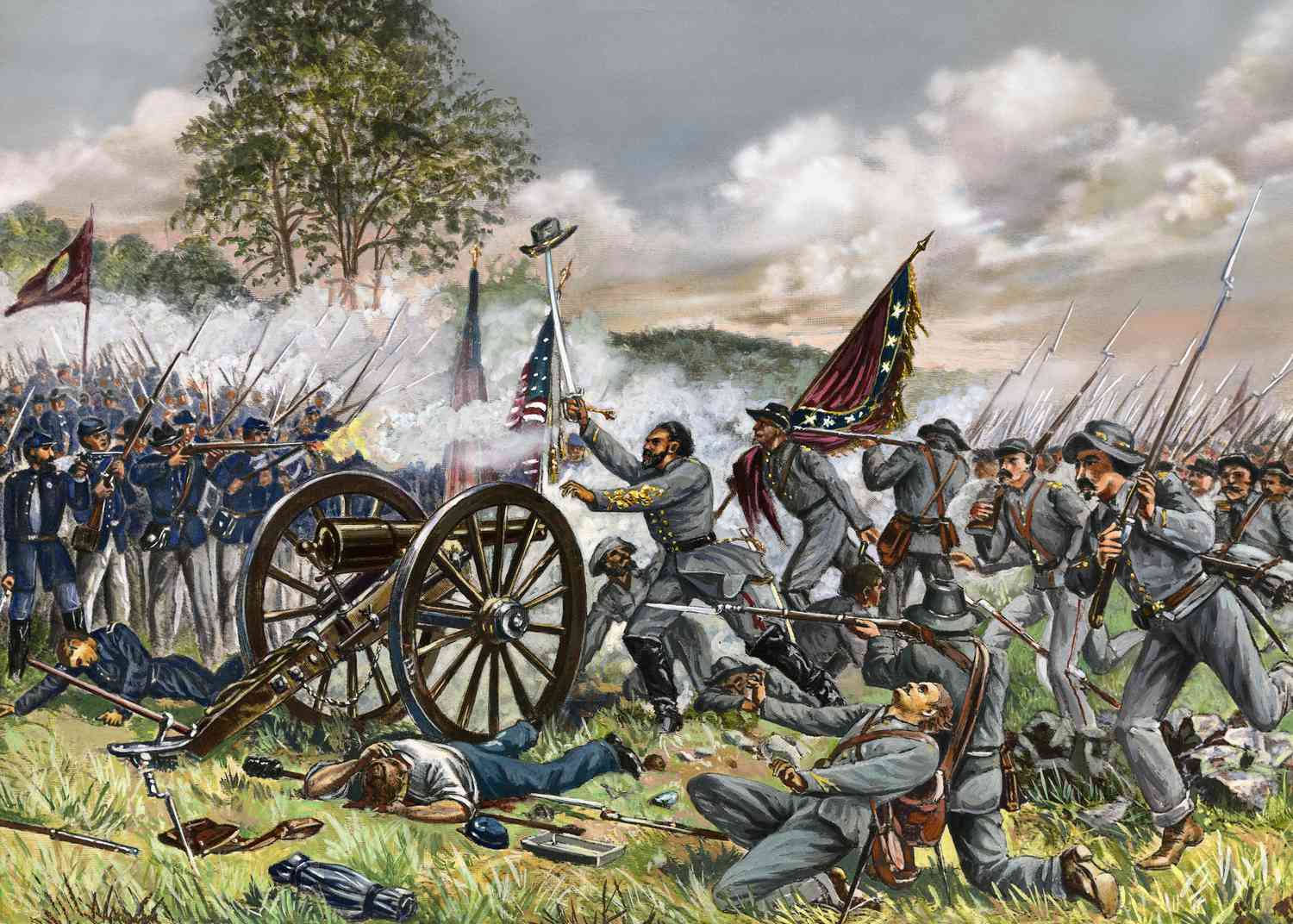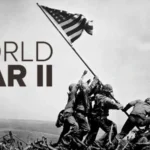
The Battle of Gettysburg, fought from July 1 to July 3, 1863, in the quaint town of Gettysburg, Pennsylvania, stands as a pivotal moment in American history. This historic clash unfolded between the Union Army of the Potomac, led by Major General George G. Meade, and the Confederate Army of Northern Virginia, commanded by General Robert E. Lee. Over the course of three intense days, the fields and hills surrounding Gettysburg bore witness to a staggering human toll and strategic brilliance. This introductory overview delves into 25 key historical facts and numerical trivia, shedding light on the significance of this monumental battle, its impact on the Civil War, and its enduring place in the collective memory of the nation.
Date: The Battle of Gettysburg unfolded over three pivotal days from July 1 to July 3, 1863, marking a crucial juncture in the American Civil War. The conflict ensued between the Union Army of the Potomac, led by Major General George G. Meade, and the Confederate Army of Northern Virginia, commanded by General Robert E. Lee.
Location: The historic town of Gettysburg in Pennsylvania served as the battleground for this monumental clash. The serene countryside transformed into a theater of war, witnessing one of the bloodiest and most consequential engagements in American history.
Casualties: The Battle of Gettysburg inflicted a devastating toll on both Union and Confederate forces, with casualties estimated between 46,000 and 51,000 soldiers. The magnitude of the losses underscored the fierce and relentless nature of the conflict, leaving an indelible mark on the nation’s collective memory.
Commanders: Two illustrious military leaders helmed the opposing forces during this epic confrontation. Major General George G. Meade, a relatively new commander of the Union Army, faced the seasoned and formidable General Robert E. Lee, who led the Confederate Army with a reputation for tactical brilliance.
Troop Strength: The numerical balance of forces played a critical role in shaping the dynamics of the Battle of Gettysburg. The Union Army, with approximately 93,000 troops, faced off against a Confederate force numbering around 71,000 soldiers, setting the stage for a monumental struggle for supremacy.
Pickett’s Charge: July 3 witnessed one of the most iconic moments of the battle—Pickett’s Charge. General Lee ordered approximately 12,500 Confederate soldiers to launch a daring assault on the center of the Union line. The outcome of this ill-fated charge would significantly influence the course of the war.
Cemetery Hill: A strategic high ground, Cemetery Hill emerged as a linchpin in the Union defense. Control of this vantage point was hotly contested, and its significance was pivotal in shaping the ebb and flow of the battle.
Little Round Top: This unassuming hill on the southern end of the battlefield became the focal point of intense fighting. Notably, the 20th Maine Regiment, led by Colonel Joshua Chamberlain, played a heroic role in repelling Confederate attacks, securing their place in history.
Devil’s Den: A rocky outcrop on the battlefield, Devil’s Den witnessed fierce combat and became a symbol of the brutal nature of the conflict. The famous photograph by Alexander Gardner capturing Confederate casualties among the rocks is a haunting reminder of the human cost of war.
The Wheatfield: The expansive Wheatfield, a seemingly mundane agricultural feature, turned into a battleground of ferocious fighting during the second day of the battle. The fields soaked in the blood of thousands of soldiers, highlighting the brutal realities of war on this hallowed ground.
Days of the Battle: The Battle of Gettysburg unfolded across three pivotal days, each marked by distinct strategic developments. On July 1, initial skirmishes set the tone as Confederates gained early successes. July 2 witnessed intense fighting at key locations, including Little Round Top and Devil’s Den. Pivotal to the battle, July 3 culminated in General Lee’s fateful decision to launch Pickett’s Charge, a decision that ultimately turned the tide of the conflict.
Culp’s Hill: Situated on the Union right flank, Culp’s Hill played a crucial role in the Battle of Gettysburg. Union forces successfully repelled repeated Confederate attacks on this elevated position, securing their defensive line and contributing to the overall Union victory.
20th Maine Regiment: The 20th Maine Regiment, led by Colonel Joshua Chamberlain, earned its place in history for its heroic defense of Little Round Top. Facing a determined Confederate assault, the regiment executed a daring bayonet charge, preventing a breakthrough and solidifying its reputation as one of the most storied units of the Civil War.
150 Cannons: Artillery played a significant role in the Battle of Gettysburg, with the Union deploying approximately 150 cannons. The thunderous roar of artillery fire echoed across the battlefield, shaping the course of engagements and contributing to the overall intensity of the conflict.
Lost Cause Monument: Erected by the Confederacy, the Lost Cause Monument stands as a poignant memorial to the soldiers from the South who fought at Gettysburg. It reflects the post-war sentiment among Confederate sympathizers who sought to honor the bravery of their fallen comrades.
25% Casualty Rate: The Battle of Gettysburg exacted a staggering human toll, with an estimated casualty rate of around 25% for both Union and Confederate forces. This grim statistic underscores the ferocity and brutality of the engagements that unfolded on the fields of Gettysburg.
High Water Mark of the Confederacy: The term “High Water Mark” refers to the farthest advance of Confederate forces during Pickett’s Charge on Cemetery Ridge. It symbolizes the zenith of Confederate aspirations during the battle and, ultimately, the beginning of their decline.
Gettysburg Address: President Abraham Lincoln delivered the Gettysburg Address on November 19, 1863, during the dedication of the Soldiers’ National Cemetery. In just a few brief but profound sentences, Lincoln eloquently articulated the principles of equality and national unity, forever associating Gettysburg with a solemn dedication to the principles of democracy.
Patriotism and Sacrifice: The Battle of Gettysburg is often remembered as a testament to the patriotism and sacrifice displayed by soldiers on both sides. The profound commitment to duty and the high cost of preserving the Union or pursuing independence shaped the legacy of this monumental conflict.
Longstreet’s Corps: Confederate General James Longstreet’s corps played a significant role in the Battle of Gettysburg, especially during the second day of fighting. Longstreet’s tactical prowess and leadership were evident in the intense engagements at places like Devil’s Den and the Wheatfield, contributing to the overall ebb and flow of the battle.
71 Days to Gettysburg: The Battle of Gettysburg was preceded by a significant leadership transition. Major General George G. Meade assumed command of the Army of the Potomac just 71 days before the battle. Despite the relatively short time to prepare, Meade’s strategic acumen played a crucial role in the Union victory.
July 4, 1863: Although not part of the battle itself, July 4, 1863, holds historical significance as the day of General Lee’s Confederate retreat. This marked the end of the Confederate invasion of the North, solidifying Gettysburg’s reputation as a turning point in the Civil War.
Lee’s Retreat: Following the defeat at Gettysburg, General Robert E. Lee led his retreating Confederate forces back to Virginia. This retreat marked a pivotal moment in the war, as the Confederate Army faced the challenges of regrouping and recovering from the significant losses suffered during the battle.
28 States Represented: The Battle of Gettysburg drew soldiers from a broad spectrum of states, with participants hailing from 28 different states. This diverse representation highlights the widespread impact of the conflict and the national scale of the Civil War.
Gettysburg National Military Park: In recognition of its historical significance, the Gettysburg National Military Park was established to preserve the battlefield and honor the soldiers who fought there. This park serves as a solemn memorial and educational site, attracting millions of visitors annually who come to pay their respects and learn about this critical chapter in American history.
FAQs about The Battle of Gettysburg:
What happened at the Battle of Gettysburg?
- The Lead-up:
- Confederate General Robert E. Lee led his Army of Northern Virginia northward, invading Pennsylvania.
- The two armies met unexpectedly at Gettysburg, leading to a three-day battle.
- The Battle:
- Day 1: Fighting began on July 1st as Confederate forces encountered Union cavalry. The fighting escalated, and the Confederates pushed the Union troops back through Gettysburg to positions on Cemetery Hill and Culp’s Hill.
- Day 2: On July 2nd, Lee launched attacks on the Union left flank, resulting in intense fighting at places like Little Round Top, Devil’s Den, the Wheatfield, and the Peach Orchard. Simultaneously, Confederate forces attacked the Union right flank at Culp’s Hill and East Cemetery Hill.
- Day 3: On July 3rd, Lee ordered a massive assault on the Union center, known as Pickett’s Charge. This attack was repulsed by the Union forces, resulting in heavy Confederate losses.
- The Outcome:
- The Union Army, under Major General George G. Meade, emerged victorious.
- Lee’s Army of Northern Virginia was forced to retreat.
Why was the Battle of Gettysburg so incredibly important?
- Turning Point:
- Gettysburg is widely considered a turning point in the Civil War. It halted Lee’s second invasion of the North and significantly weakened the Confederate Army.
- It marked the beginning of the Confederacy’s decline.
- Moral Boost:
- The Union victory boosted Northern morale, while the Confederate defeat dealt a severe blow to Southern hopes of victory.
- International Impact:
- A Confederate victory at Gettysburg might have led to European recognition of the Confederacy, which could have changed the course of the war.
- The Gettysburg Address:
- President Abraham Lincoln’s Gettysburg Address, delivered at the dedication of the Soldiers’ National Cemetery in November 1863, further solidified the battle’s significance and redefined the purpose of the war.
Is Gettysburg the bloodiest battle in American history?
- While Gettysburg was exceptionally bloody, it is generally considered to be one of the bloodiest battles in American History. But it is not always listed as the number one bloodiest.
- The battle of Antietam, also in the civil war, had a higher number of casualties in a single days fighting. So depending on how you measure “bloodiest” the answer can vary.
How many died at the Battle of Gettysburg?
- Casualties were extremely high on both sides.
- Estimates vary, but the total casualties (killed, wounded, and missing) were over 50,000.
- Specifically:
- Union casualties: Approximately 23,000.
- Confederate casualties: Approximately 28,000.









